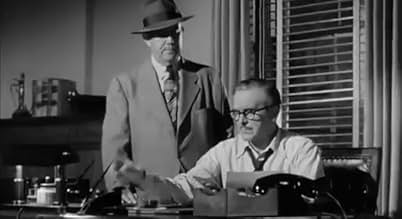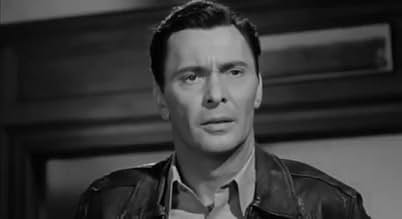Fed up with the rising crime rate in Miami, the police chief and leading members of the city council hire a former gangster who's gone straight to help eliminate the biggest crime syndicate ... Read allFed up with the rising crime rate in Miami, the police chief and leading members of the city council hire a former gangster who's gone straight to help eliminate the biggest crime syndicate in the city.Fed up with the rising crime rate in Miami, the police chief and leading members of the city council hire a former gangster who's gone straight to help eliminate the biggest crime syndicate in the city.
- Harry Dobey - Editor
- (uncredited)
- Charles Earnshaw
- (uncredited)
- Clifton Staley
- (uncredited)
- Simmons, Detective
- (uncredited)
- Gil Flagg
- (uncredited)
- Police Lieutenant
- (uncredited)
- Kingsford - Detective
- (uncredited)
- Gangster
- (uncredited)
Featured reviews
Overall, I found The Miami Story very enjoyable. Sure, there are issues with the plot that require a gigantic leap in logic, but if you're willing to look past these issues (and I looked past most - not all, but most), it's a fairly rewarding and entertaining experience. The film is more graphic than most I've seen from the era, with a woman being badly beaten-up, more blood than I expected, and a more explicit inference of prostitution. For 1954, this is about as far as you could go in the depiction of the sleaze and nastiness resulting from crime. The acting is particularly noteworthy. Barry Sullivan (rock solid and believable in the lead), Luther Adler (the perfect baddie), and Adele Jergens (as the tough-as-nails "dame") are all outstanding. But I was happiest to see Beverly Garland's fantastic performance. I've always been a fan regardless of the dreck she sometimes appeared in. The Miami Story also benefits from solid direction. Fred Sears' pacing is perfect. From the opening shootout to the final chase, The Miami Story rarely lets up. And, the film looks fantastic. I especially enjoyed the shots of Miami from the 50s - how things have changed! It's all nicely done.
Finally, I've often seen The Miami Story listed as a film noir. I'd argue that's not exactly accurate. I could cite a number of reasons, but the main one is the film's ending. You don't get that in a typical noir.
6/10
The story itself, however, is quite good. Apparently, a mob has taken hold in Miami and a secret committee decides to call in an ex-mobster to help. Mike Flagg (Barry Sullivan) now lives a normal life and he apparently hates the mobs. Now, he returns to Miami...playing up that he is a mobster and is now working with a Cuban mob. This new mob, according to Flagg, is there to take over from the existing mob...in an attempt to get the mob leader (Luther Adler) to try to wipe them out and incriminate themselves. What's next? See the film.
The film is tough, well acted and enjoyable. Not perfect (mostly due to the narration) but very good.
The acting, under the prolific Fred Sears, is good, and the story wobbles from the tracks laid down by Sullivan to keep things interesting. And, as the voice-over by William Woodson -- this is the era when every crime drama was influenced by DRAGNET -- Miami has been squeaky clean ever since. Just ask Don Johnson and Philip Michael Thomas.
It is a middling effort, standard B flick with standard b&w photography and unremarkable acting. The script really stretches your suspension of disbelief, especially the decision to send former criminal Mick Flagg (Sullivan) into the lion's den, in order to cure the town of its crime pandemic.
One positive aspect about MIAMI STORY: 75' long.
Did you know
- TriviaEven though this was filmed while the Motion Picture Production Code (colloquially referred to as the Hays Code) was still being enforced, the filmmakers were able to push back on some of the limits, evidence that the Code was weakening in the 1950s. This film fairly graphically shows two men after being shot dead, shows a woman who had been badly beaten, and talks openly about prostitution and underage prostitution. The filmmakers most likely argued these "shocking" scenes would reiterate the pro-law-and-order message.
- GoofsMick Flagg obviously pulls his punches in several shots.
- Quotes
[first lines]
[as a montage starts, a voice can be heard narrating]
Narrator: In the years following World War II, organized crime in the United States grew to such proportions that it's scope was greater than the law enforcement agencies that tried to fight it.
[a shot of the U.S. Capitol Building can be seen]
Narrator: Finally, in the nation's capitol, the Senate Investigating Committee presented a new threat to gangland, and panic began to grip the overlords of crime.
[a montage of Miami can be seen playing]
Narrator: They sought a new central headquarters for their operation. The city where they felt they could be safe. They chose the Miami area, a vacation wonderland, a Mecca for tourists, who swelled the normal population of 600,000, to more than 2 million in the winter season. A city where the tough, honest police force was inadequate in size to protect the tremendous overflow of people. Then, out of sheer necessity, a way was found to crush crime in Miami. As Senator George Smathers, of the State of Florida relates...
- How long is The Miami Story?Powered by Alexa
Details
- Release date
- Country of origin
- Official sites
- Languages
- Also known as
- Secretos de Miami
- Filming locations
- Miami, Florida, USA(location shooting)
- Production company
- See more company credits at IMDbPro
- Runtime1 hour 15 minutes
- Color
- Aspect ratio
- 1.37 : 1
Contribute to this page


































